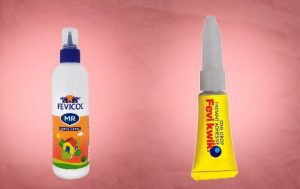Explained: Why Fevicol, Fevikwik don’t stick to their own containers

Glues like Fevicol and Fevikwik are our go-to fixers for everything from broken mugs to school projects and sometimes even shoes. While these powerful adhesives bond surfaces effortlessly, have you ever paused to ask — why don’t they stick to the very tubes or jars they come in?
Let’s peel back the label and explore the science behind it.
What exactly is glue, and how does it work?
At its core, glue is made of polymers — long chains of molecules that can be either sticky, stretchy, or both. Manufacturers choose a polymer that balances flexibility with adhesive strength.
In the case of white glues like Fevicol, water is added to the polymer to act as a solvent. This water keeps the glue in a semi-liquid form while inside the container. When you apply it to a surface, the water begins to evaporate, leaving behind only the sticky polymer, which then binds the surfaces together.
It’s important to note — glue doesn’t actually “dry” in the traditional sense. Instead, it cures or hardens as the water evaporates.
So why doesn’t it stick inside the bottle?
Here’s the trick — white glues like Fevicol only begin to harden when exposed to air. As long as the bottle remains sealed, the water inside doesn’t evaporate, keeping the glue soft and usable. But leave the cap open, and you’ll see it harden around the rim — that’s because the water begins to escape, and the glue starts bonding right there.
What about Fevikwik and similar fast-drying glues?
Unlike Fevicol, Fevikwik doesn’t rely on water-based polymers. Instead, it contains cyanoacrylate, a fast-acting adhesive that bonds in the presence of moisture — yes, even the small amount of moisture in the air.
This means Fevikwik must be stored in completely dry, airtight containers. The packaging is designed to prevent even the tiniest trace of moisture from entering. If the cap is left open, the glue reacts with moisture in the air, hardens quickly, and seals itself inside the tube.
The bottom line
So, whether it’s a white glue like Fevicol or an instant adhesive like Fevikwik, the secret to why they don’t stick to their own containers lies in chemistry and careful packaging. It’s not magic — it’s science that ensures these adhesives stick only when and where we want them to.
PNN
News